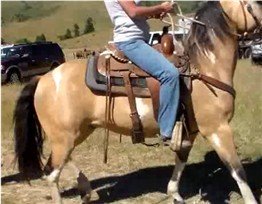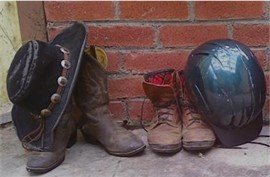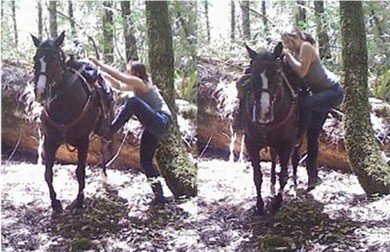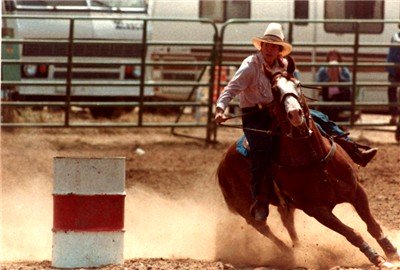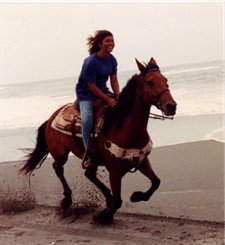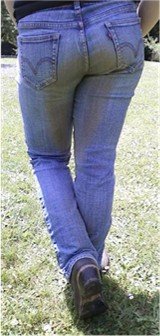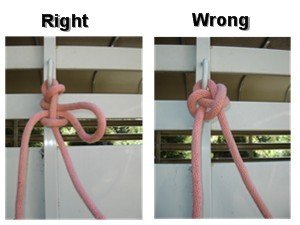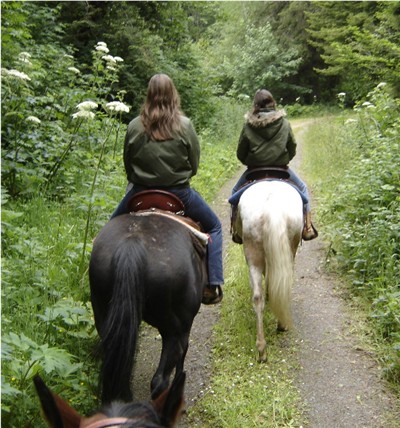Learn How To Ride A Horse
Horse riding Tips for New Riders
Do you need tips on how to ride a horse? Do you want to know how to ride without bouncing all over the saddle? With English and Western riding, the basic principals are the same. You will learn how to mount and dismount, how to hold the reins, how to stop, turn, move forward and backwards...and how to gallop when you're ready.
Horse Riding Tips on Clothing
Boots · Pants · Hat
or Helmet
Before we talk about riding we need to go over a few safety issues. Horseback riding is a very physical activity and you’ll want to wear clothing that will both protect you and allow for unrestricted movement. No matter if you are riding Western or English style, the same rules apply.
You will need a pair of boots with a heel. Boots will serve two purposes. A quality leather boot will protect your foot should you happen to get stepped on, which does happen occasionally even to the most experienced horseman. But more importantly, the heel of your boot will prevent your foot from slipping all the way through the stirrups on your saddle. Heaven forbid you were to fall from the saddle with your foot jammed all the way through a stirrup on a runaway horse.
As a horseback rider, wear pants that will let you move freely. You will notice English riders wear pants made of stretchy fabric. If you are riding western style, stay away from skinny jeans. My mare is so tall I have to lift my foot as high as my belt buckle to reach the stirrups. You’ll need jeans loose enough that you can move in them. How to ride a horse without showing the whole world your crack... don’t wear low rise jeans.
More Horse Riding Tips
Nowadays everyone seems to be into protecting their heads. If you are one of them you’ll need a helmet. Get one designed specifically for horseback riding. If you are learning how to ride a horse in an arena, be prepared to meet the helmet requirements. Personally I don’t wear a helmet…I can’t stand them, but that is my own personal choice. At minimum you will want a hat with a brim to protect your eyes from sun, rain, dust, limbs, cobwebs and any other thing that you may run into on the trail. The brim of my old hat has protected me from sandblasting windstorms on the beach, torrential rains and countless wayward limbs on overgrown trails.

How to Ride a Horse - Mounting and Dismounting
Most horses are trained to have the rider mount and dismount from their left side. Don’t ask me why. The horse’s right side is referred to as the off side. I tell my kids to think of it like driving a car. The driver always gets in and out on the drivers side. You will mount and dismount your horse from the driver’s side as well.
In a perfect world, horses would stand completely still while you climb into the saddle. But the reality of it is, that most horses will fidget, move and even start to walk off, especially if the horses around them are already on the move. Because of this you will need to know how to get on while maintaining control of your horse.
To mount a horse, stand at the horse’s side facing the saddle with your left shoulder about even with the saddle horn. Take the reins in your left hand in such a way that your horse’s head is pulled around toward you. Grab a hold of the saddle horn with your left hand. You will now be holding the saddle horn and the reins in your left hand. Use your right hand to hold the stirrup while you put your left foot into it.
At this point you may be feeling like you are in a game of twister. It is a rather awkward position to be in, while you are standing with on one leg on the ground and one foot in the stirrup, especially if your horse is moving around. That is why you will want to do this in one quick smooth motion if you can. Once you have your foot in the stirrup, step up, using the stirrup as your foot hold and throw your right leg all the way over the horse’s rump and to the other side of the saddle. Use the saddle horn to help pull your self up. Keep hold of those reins!
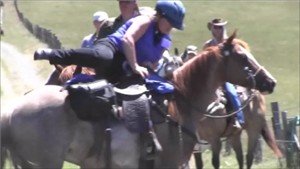 Notice the rider has the reins in her left hand
Notice the rider has the reins in her left handIf your horse does begin to move off, and you have taken the reins with the horse’s head pulled toward you, the horse will only be able to move in tight circles, while you get yourself adjusted with both feet in the stirrups. You maintain control.
To dismount, you will do the same thing only in reverse. Take the reins and the saddle horn in your left hand. Put your weight in the left stirrup while throwing your right leg over the horses rump and too the ground. All the while holding onto the saddle horn to maintain your balance. When your right foot is on the ground, step your left foot out of the stirrup. Many riders will kick both feet put of the stirrups and throw their right leg over the horse’s rump and slide off with both feet hitting the ground at the same time. This is OK too.
How to Ride a Horse – Feet, Seat and Reins
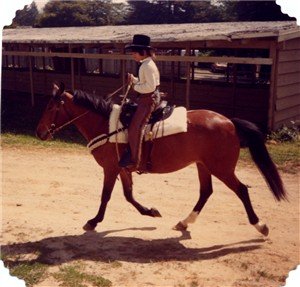 Good seat and feet position
Good seat and feet positionYou can always tell when someone has never ridden a horse before, because they usually have a death grip on the saddle horn. But you won’t, because you’ll know that the saddle horn is not what keeps you in the saddle. Riding a horse is much like riding a bicycle. A bicyclist does not cling desperately too the seat of their bicycle.
A bike rider uses their balance to stay on the bike and that is what you are going to do to stay in the middle of your saddle. When a bicyclist starts to fall over what do they do? They put their foot out to the ground to catch themselves. That is what you will do with your feet in the stirrups. The stirrups are your ‘ground’. If you find yourself sliding to the right or left, use your feet and your stirrups to push yourself back to the center.
Horse Riding Tip
Use your feet in the stirrups to push yourself back to center, if you start to fall to one side or the other.
Another sure sign of a beginner rider is when they lean forward over the saddle horn as if to cling to the horse’s neck. Bicyclists don’t hug their handlebars. They sit in the seat and steer the bike. It’s all about balance. When a rider leans forward and lets the heels of their boots ride up toward the sky, their whole balance is thrown forward….it’s a good way to fall off.
You want to sit strait in the saddle with your pelvis tucked slightly forward. Don’t jam your boots deep into the stirrups, but rather ride on the balls of your feet, toes turned in slightly and heels pointing down to the ground. Stretch those calf muscles! This position will keep your butt seated deep in the saddle…right where you want it to be.
Now that you’re properly seated, you’ll want to take hold of the reins. Just like a bicyclist, sometimes you’ll use one hand and sometimes you’ll need two hands on the rein. When you need two hands, you will not be gripping the saddle horn. Your deep seat, downward pointed heels and stirrups will keep you in the saddle, while your hands control the horse.
Hands are Firm, Yet Gentle
The reins are attached directly to the bit in the horse’s mouth. A heavy hand on the rein is painful and even damaging to the horse’s mouth. Never jerk and yank on a horse’s mouth. Hold the reins so that your hands are about even with the saddle horn. You’ll want enough slack in the rein so the horse can move forward freely, but not so much slack that you can’t stop the horse without pulling the reins all the way up to you ears.
How to Ride a Horse – Moving Forward and Turning
The trick to riding a horse is to give the least amount of effort to get the response that you want. Every horse is different. Some horses will respond to the slightest touch and others will take a little more prodding. To move forward lift the rein off the horse’s neck. For some horses, this is all they need to start moving out. If not, then add more signals simultaneously as needed. Make a click, click sound, lean slightly forward, push your horse with a hip thrust and lastly touch your heels to their sides. Rarely will you need to actually kick the horse. A whip is virtually never needed to get a horse to move out. Once your horse is walking, give them enough rein to move out freely.
Turning Your Horse – How to Ride a Horse With Your Whole Body
Notice this riders feet and hand position. Her weight is shifted toward the turn. She is looking the direction she aims to go.
Horses are taught to move away from pressure. When you are standing on the ground and you push the horse with your hand, they move away from you. As I mentioned before, all horses are different. Some horses have been taught to neck rein. A horse that neck reins will move away from the mere pressure of the rein against their neck. To make a right turn on a neck reining horse, simply move your hand to the right and the left rein will touch the horse’s neck and the horse will turn away from it. For a left turn, move your hand to the left. A neck reining horse can be steered with just one hand on the rein.
Here is how to ride a horse that does not neck rein. For these horses you will want to reach down slightly lower on the rein and then pull to guide the horse’s head toward the direction you want to turn. Pull the right rein to turn right and the left rein to turn left. Use a firm but gentle hand when asking for a turn. Remember the golden rule…use the least amount of effort needed to get the desired result.
Horse Riding Tip
Always look in the direction you want the horse to move.
You will reinforce your reining signal to the horse by using the rest of your body as well. Remember riding a bike? Look in the direction you want to turn. Shift your weight slightly in the saddle toward the direction you want to turn. And if needed press the opposite leg to your horse’s side. Remember that a horse moves away from pressure. He will move away from your leg. When your horse has turned, even your reins out and continue riding.

How to Ride a Horse Faster than a Walk
Horses have 4 speeds - a walk, a trot, a lope and a run, each one faster than the next. Once you have learned the basics of how to ride a horse at a walk, you will eventually want to ask your horse to go faster. To do this, lift your rein and lean forward in the saddle. Add clicking sounds if needed and reinforce with your heels to their sides if you must.
Horse Riding Tip
The further you lean forward, the faster your horse will go.
The further you lean forward, the faster your horse will go. That’s why new riders that don't know how to ride a horse will often spiral out of control. When they lean over, gripping the saddle horn without keeping their heels down, they have no control over their balance or the horse. In leaning forward, they are asking the horse to go faster. Not wanting to go faster, they cling desperately to the saddle horn, unable to use their hands on the rein to ask for a stop, and completely loose all balance and fall off.
If you have never ridden a horse before, I highly recommend you master learning how to ride a horse at a walk before you move on to the faster speeds. And stopping.....don’t forget to master the stop before you go speeding off into the wild blue yonder. More on that later.
How to Ride a Horse at a Trot Without Bouncing
Some horses have a soft smooth trot that is easy to ride. Some horses have a trot so rough it will shake your teeth loose. Usually the faster the trot, the rougher it is (a slow trot is called a jog). To ride a trot comfortably, you’ll want to shift your weight from your butt, to the balls of your feet in the stirrups, while leaning slightly forward. This will allow your knees so act as shock absorber rather than pounding the heck out of your body. You’ll need good balance to do this. This is not the time to hold the saddle horn. You will want both hands on the reins so you can maintain complete control over the speed of your horse.
How to Ride a Horse at a Gallop
Ask your horse to move from a trot to a lope by….you guessed it; letting the rein out, leaning forward, making a clicking sound, pressing your heels to the horse or giving a slight kick if necessary. A lope may be faster than a trot, but it is much easier to ride! Once you get your horse up to speed, sit up straight, keep your heels down, pelvis tilted slightly forward, butt seated deeply in the saddle and stay relaxed. Let yourself get in to the rhythm of your horses movements. That's how to ride a horse at a lope!
How to Ride a Horse at a Run (full speed)
More Horse Riding Tips
When you are a riding a horse confidently and ready for a full out run…what a thrill it is! Once you have your horse up to a lope, use all the signals you have learned to ask for more speed. At this point you will be riding low over the horse neck with your hands forward to give your horse full rein. You’ll be riding on the balls of your feet and you may or may not be actually sitting in the saddle. Again, don’t try this until you have mastered the other speeds first.
Now that we have gone over the basics of how to ride a horse moving forward, it’s time to learn how to stop a horse, how to slow them down to adjust your speed, and how to back them up.
More on How to Ride a Horse
How to Stop a Horse
Every rider needs to know how to stop a horse, so let’s get started. Learn how to use your weight, hands and feet to get the horse to stop, slow down and back up.
Bareback Riding
The benefits of bareback horse riding are priceless. Riding bareback is arguably, the fastest way to develop your skill as a rider. Read more to learn why…
Equestrian Safety
Equestrian Safety - This is a straight forward practical guide to keeping you and your horse safe from injury.
Horse Keeping Cost
Cost to Own a Horse - Find out just how much is costs to own a horse form purchase price, to monthly expenses to incidentals. Find out what basic supplies you'll need.
Tips for the Trail Rider
How to ride a horse for - The trail rider. The trial rider runs into obstacles that will never be seen in the arena. One thing for sure, it’s never boring! If you are new to the equine world, these horse riding tips will be most helpful.
